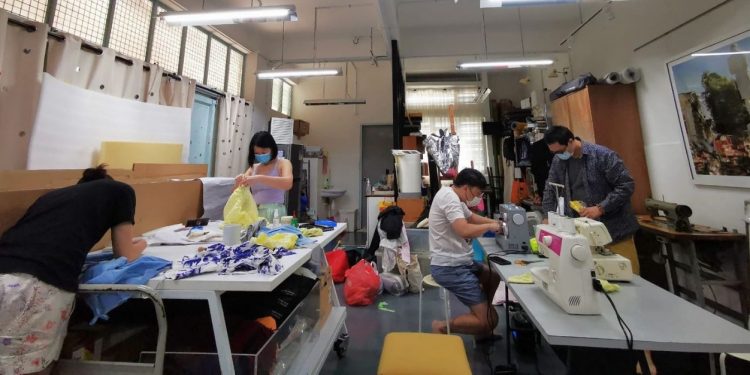In 2020 alone, Singapore discarded 137,000 tonnes (137 million kilograms) of fashion waste, of which only four per cent is recycled, according to the National Environment Agency. If the large number is hard to fathom, that is equivalent to the weight of more than 11,000 double-decker buses.
In this second iteration of the Renew Earth Sweat Shop, Post-Museum seeks a way to elevate the art of upcycling fashion scraps to the commercial market. Upon the embarkation of the project, they rapidly amassed over 200kg of fashion waste from swap shops, thrift stores, green movements, and everyday individuals who have been looking for a better use for their fashion scraps.
The first month of the Renew Earth Sweat Shop was a reconnaissance mission. Throughout May, organisers visual artist Veronyka Lau and artist-curator Woon Tien Wei met with over 80 individuals virtually to brainstorm ideas for viable upcycling projects.
During these discussions, Ms Lau and Mr Woon quickly realised that upcycling is no longer a project limited to individuals or isolated groups; instead, there was potential for it to expand beyond, and transform into something that became part and parcel of the fashion industry. Participants were encouraged to rethink the idea of waste in their projects, and consider how such materials could be used on an industrial and/or retail scale.
On their end, they sought out partnerships with technology providers and professionals to lend guidance and equipment to interested participants, allowing them to bring their ideas into reality.
At the moment, approximately 30 participants are working on products made from fashion waste, in preparation for the exhibition come end-August. Amidst the constantly changing safe management measures the past few months, TheHomeGround Asia speaks with four participants in the Renew Earth Sweat Shop to glean greater insights into their projects, and their goals for the future of fashion sustainability.
A shoemaker walking the talk
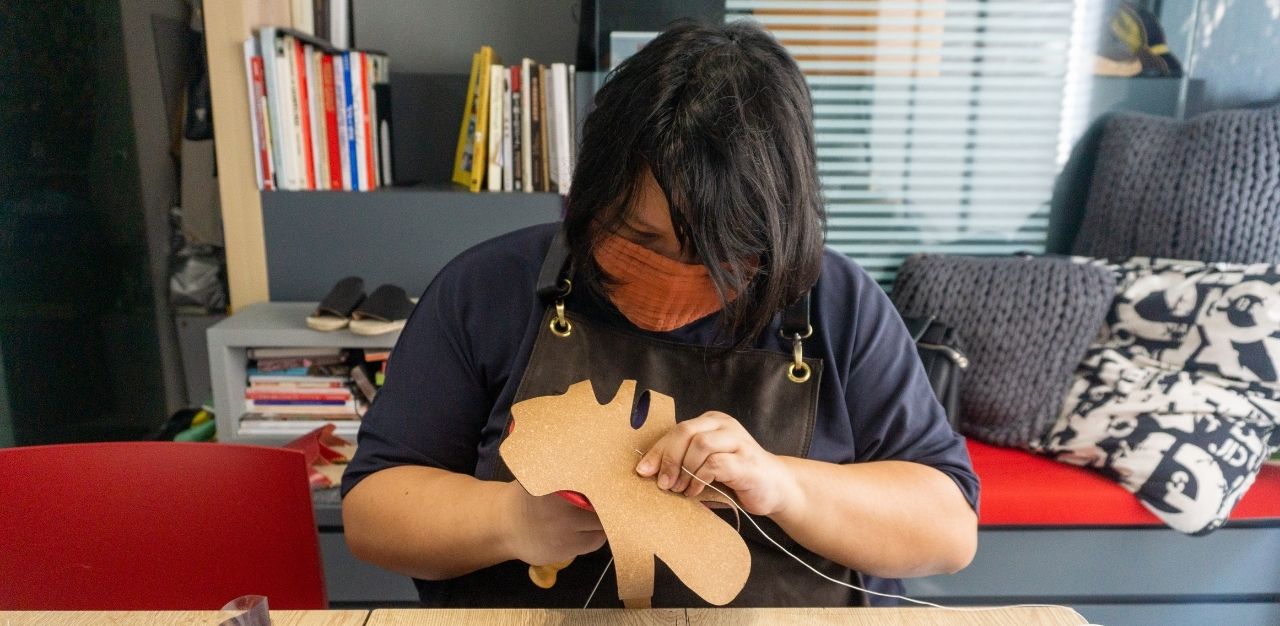
Lisa Teng does not consider her shoemaking company, Lisa Teng Studios, to be a green company. This is despite her using waste or scrap materials as far as possible to create her shoes. Instead, she is transparent about her practices – while she endeavours to be sustainable as far as possible, there are times when purchasing brand new materials are necessary.
Ms Teng opines, “Most companies should be sustainable, even if they don’t declare that they are green. It is something that needs to be part of your behaviour on a daily basis.”
Action speaks louder than words, and while Ms Teng is not outrightly vocal about her commitment to sustainability, she demonstrates it clearly in her work – by using scrap materials wherever possible, reducing waste through creative use of materials, and only making shoes to order.
Ms Teng also carries out shoemaking workshops, which she hopes will help participants appreciate the sheer amount of labour and materials that goes into making a pair of shoes: “The majority of [participants], once they make a pair of shoes, they realise, ‘Oh my goodness, I will think again of how I would spend my money…because I didn’t know it takes that much effort to make just a simple pair of shoes.”
Coming on board the Renew Earth Sweat Shop, Ms Teng’s experience with sustainable shoemaking can now be put in the spotlight. For the exhibition, she is creating shoes made with 80 to 90 per cent discarded materials. Through the creative use of materials like IKEA floorboards, thrifted gloves found in a charity shop, hotel bedroom slippers, and more, Ms Teng will be presenting an assortment of shoes that are fashionable, functional, and most importantly, sustainable.
As she strives to do her part for the environment, she hopes that others, too, will make little steps in the right direction: “It just takes one action to be sustainable. It doesn’t have to be anything big, but if the whole population does just one sustainable activity in their daily practice, it makes a huge difference with the environment.”
An architect on a mission of sustainable functionality
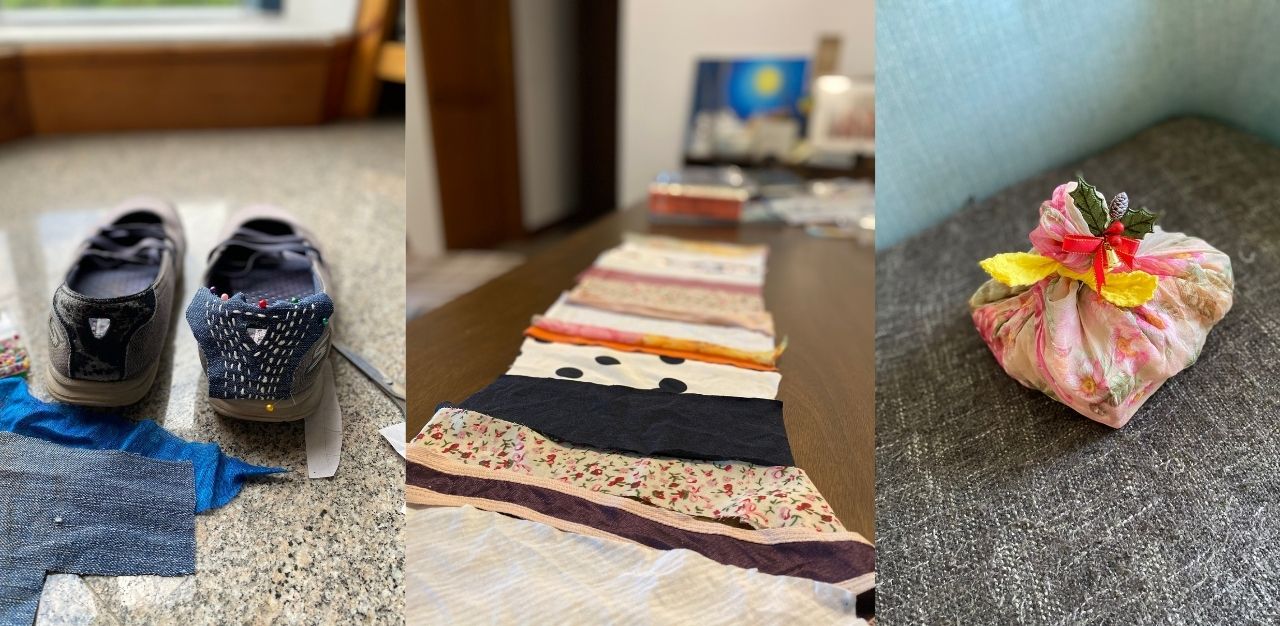
As an architect by training, Harini Ravichandran’s creations follow the philosophy of ‘form follows function’. Embarking on her second year at the Renew Earth Sweat Shop, Ms Ravichandran has several guiding principles when deciding on her project: What do I need to create it? Can I make it myself? Can I use materials that I already have, or am able to borrow from others?
Answering these questions sees her creating useful, everyday items, in the form of tote bags and produce bags, reducing her consumption of plastic and packaging waste outside of the Sweat Shop.
She says, “I put it [the bags] to test at some supermarkets, and this reassured me that leading a zero-waste lifestyle does not have to be a huge hassle.”
Besides mere practicality, Ms Ravichandran shares that this year’s Renew Earth Sweat Shop has also encouraged her to be “bolder in terms of artistic expression”, and to develop different ways to use fashion waste and transform it into textile art. Inspired by her research into various materials and weaves, and how they can be used differently, she is attempting to make a plush toy for her four-month-old niece.
As a second-time participant, Ms Ravichandran is looking forward to how this year’s Sweat Shop can make fashion repair “more accessible and mainstream, and to create more maker spaces with a repair element.” Beyond ground-up initiatives, she also hopes that this can lead to more discussions on a policy level, and allow for better frameworks that can lead to a circular economy within the fashion industry.
A granddaughter reviving cherished memories
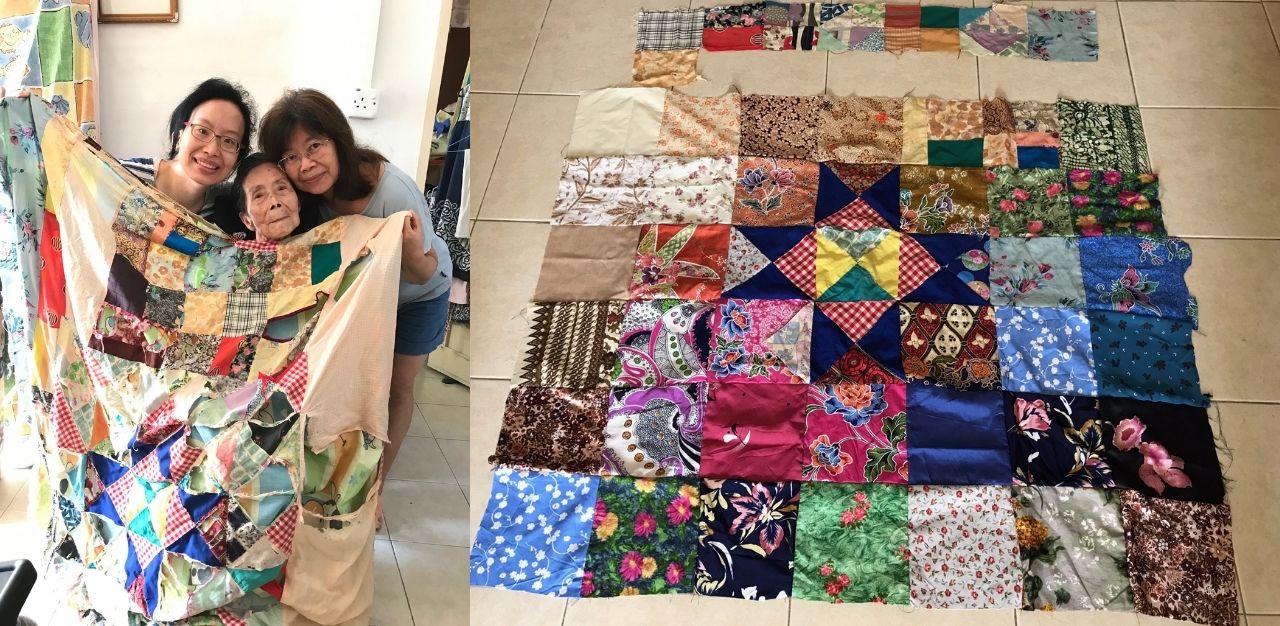
Christine Ong was at the “right place, right time”.
Four factors came together that led to her joining the programme: First, her grandmother had recently passed away, and while they were putting away her possessions, they discovered a variety of scrap fabric; Second, a patchwork quilt given to her by her grandmother had started to wear thin, and holes and tears had started appearing; Third, the location of Renew Earth Sweat Shop was close to her place; And finally, she was in the midst of clearing some leave from work, and had time to spare.
With these in mind, there was no reason not to sign up. And so, Ms Ong’s project became a way to cherish memories of her recently deceased grandmother, who had given her a patchwork quilt over 15 years back, and has been with her through various life stages. With regular use, she says, “The blanket she had made for me was falling to pieces, such that when I slept, sometimes I end up putting my hand or foot into one of the holes.”
Over the years, her mother had done her part to mend what she could, but now, an opportunity had arisen where she could add her own piece to it. Using the scrap fabrics her family had discovered her grandmother kept, alongside the fashion scraps collected by Renew Earth Sweat Shop, Ms Ong has been painstakingly mending the torn and tattered pieces of her quilt, to restore it to its former glory.
“I see the quilt as something that is a heritage for me,” she explains. “It has my grandma’s first touch, and then my mum’s add-ons. And now, I’m adding on another layer.”
A homemaker introducing sustainability to her family’s daily lives
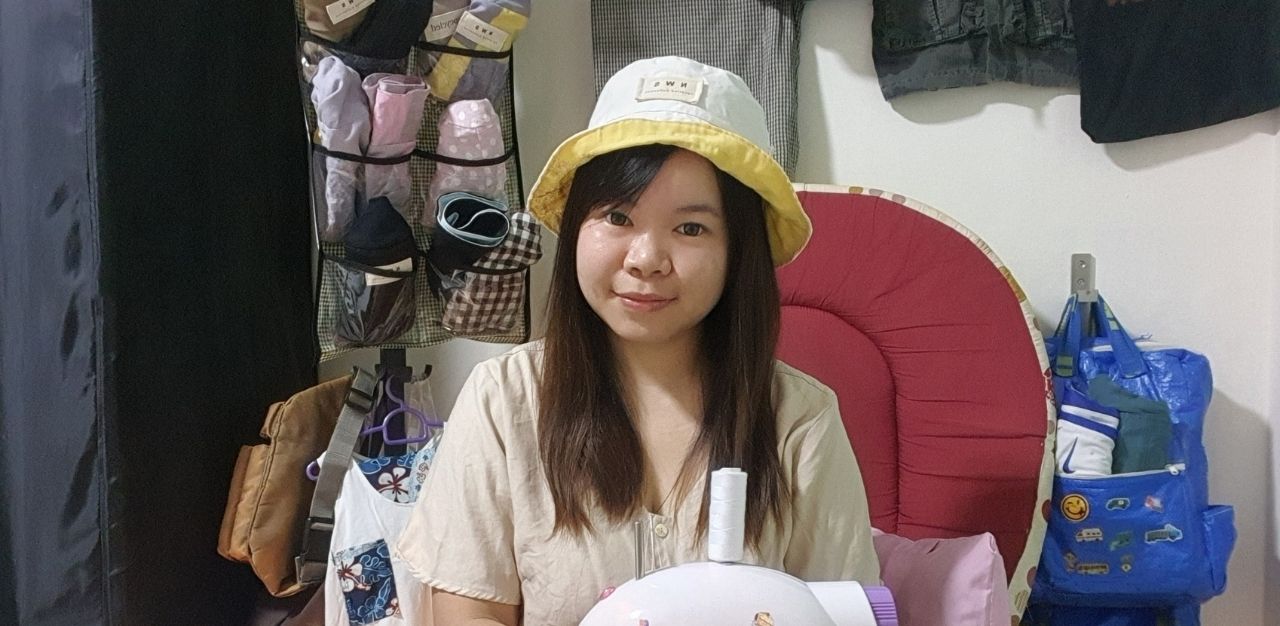
Tammy Ng is responsible for taking her five-year-old son to and from school every day. And when you are living in the balmy tropics that is Singapore, the daily walk is less of a leisurely stroll, and more of a blazing trail.
This is what inspired Ms Ng to embark on a project to create a line of bucket hats that she could use to protect herself from the sun. In line with the goals of the Renew Earth Sweat Shop, she is using only discarded fashion scraps to create them. And, they are all reversible, allowing her to maximise resources by getting two looks out of one accessory.
Upcycling as a concept is not new to Ms Ng. She has always made an effort to use items for as long as possible – some, she proudly declares, have lasted 20 years . To do so, Ms Ng is constantly repairing, mending, upsizing, upcycling, or repurposing articles of clothing or accessories to extend their life cycle.
Her exposure to upcycling started young, as a child, she would observe her grandmother sewing patchwork blankets. Taking a leaf out of her book, Ms Ng started to hand-sew dresses for her Barbie dolls using fabric waste from her grandmother’s projects. Now, as a mother, she continues that practice, sewing role-play toys for her son.
Taking part in the Renew Earth Sweat Shop has seen Ms Ng learning to use the sewing machine, opening up a world of possibilities on items that she can upcycle. With the ardent support of her husband, who purchased a mini sewing machine for her, she has started sewing various objects, such as toga tops, scrunchies, skirts, school bags, pencil cases, plush toys, and more!
And the more she sews, the more she learns. She is now more mindful about the labour that goes into every article of clothing or accessory, and the knowledge has influenced her own purchasing decisions: “I learned to buy less and reuse more. This is an important lesson especially during the worldwide pandemic when people [are] facing insecurity on their job and earnings – we have to learn and spend wisely.”
Her family is also learning alongside her. She regularly engages her son in her projects, sharing ideas on what she can sew and upcycle. Over time, her son began to introduce upcycling into his daily life as well, requesting for Ms Ng to turn clothing that he has outgrown into something new, and even coming up with his own do-it-yourself toys, such as safety helmets, surfing boards, and alarm bells.
She says, “This is something unexpected, and I’m very happy to see the positive impact happen in my family.”
Renew Earth Sweat Shop exhibition
The Renew Earth Sweat Shop will exhibit at Temasek Shophouse from 30 August to 30 September, showcasing the items that participants, including those featured above, have made. Some of the items might also be sold.
For participants interested in trying their hand at weaving, using an industrial sewing machine, or participating in the community sorting house, two workshops will be conducted each day on 11 and 12 September, from 12 to 2pm, and 2.30 to 4.30pm. Enquiries can be e-mailed to [email protected].
Join the conversations on TheHomeGround Asia’s Facebook and Instagram, and get the latest updates via Telegram.



